1997 PONTIAC BONNEVILLE light
[x] Cancel search: lightPage 72 of 405
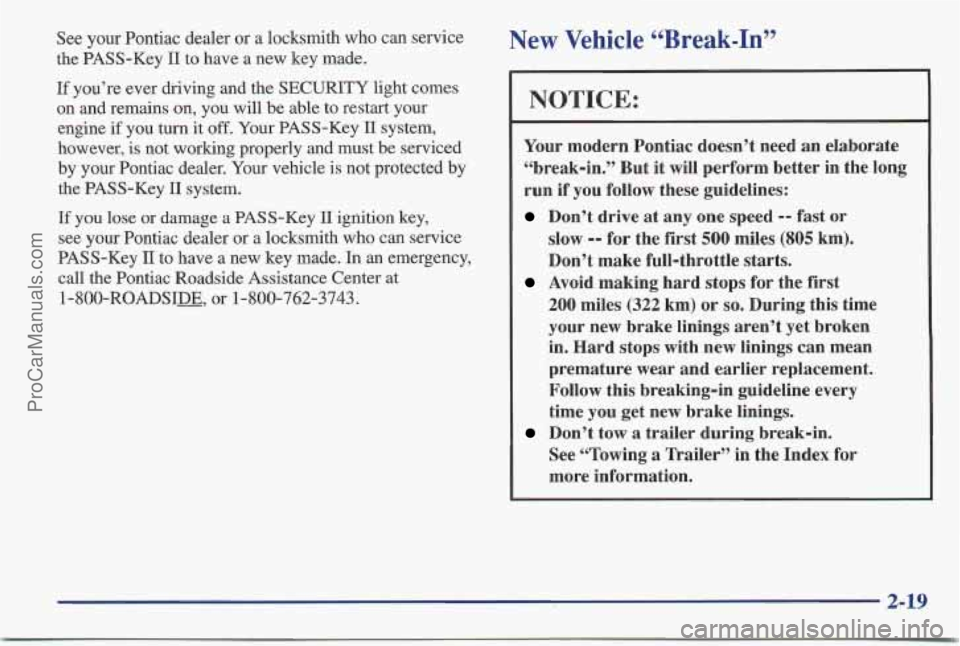
See your Pontiac dealer or a locksmith who can service
the PASS-Key
I1 to have a new key made.
If you’re ever driving and the SECURITY light comes
on and remains on, you will
be able to restart your
engine
if you turn it off. Your PASS-Key I1 system,
however,
is not working properly and must be serviced
by your Pontiac dealer. Your vehicle is not protected by
the PASS-Key
I1 system.
If you lose or damage a PASS-Key I1 ignition key,
see your Pontiac dealer or a locksmith
who can service
PASS-Key
I1 to have a new key made. In an emergency,
call the Pontiac Roadside Assistance Center
at
l-SOO-ROADSI~, or 1-800-762-3743.
New Vehicle CCBreak-In”
NOTICE:
Your modern Pontiac doesn’t need an elaborate
“break-in.” But it will perform better in the long
run if you follow these guidelines:
Don’t drive at any one speed -- fast or
slow
-- for the first 500 miles (805 km).
Don’t make full-throttle starts.
200 miles (322 km) or so. During this time
your new brake linings aren’t yet broken
in. Hard stops with new linings can mean
premature wear and earlier replacement.
Follow
this breaking-in guideline every
time you get new brake linings.
See “Towing
a Trailer” in the Index for
more information.
Avoid making hard stops for the first
Don’t tow a trailer during break-in.
2-19
ProCarManuals.com
Page 73 of 405
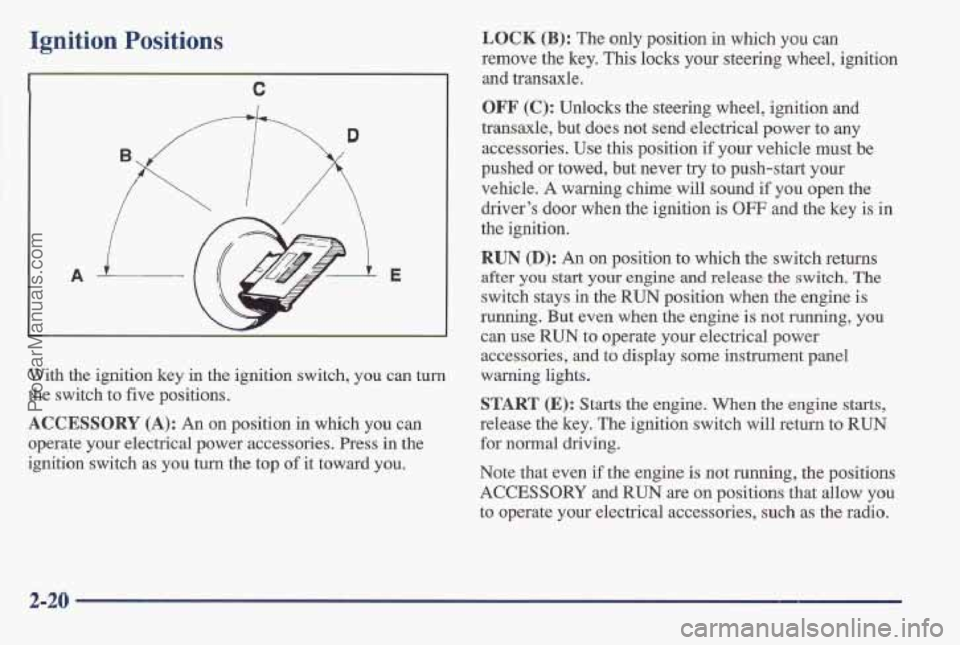
Ignition Positions
C
A E
With the ignition key in the ignition switch, you can turn
the switch to five positions.
ACCESSORY (A): An on position in which you can
operate your electrical power accessories. Press in the
ignition switch as you
turn the top of it toward you.
LOCK (B): The only position in which you can
remove the key. This locks your steering wheel, ignition
and transaxle.
OFF (C): Unlocks the steering wheel, ignition and
transaxle, but does not send electrical power to any
accessories. Use this position if your vehicle must be
pushed
or towed, but never try to push-start your
vehicle.
A warning chime will sound if you open the
driver’s door when the ignition
is OFF and the key is in
the ignition.
RUN (D): An on position to which the switch returns
after you start your engine and release the switch. The
switch stays in the RUN position when the engine is
running. But even when the engine is not running, you
can use RUN
to operate your electrical power
accessories, and
to display some instrument panel
warning lights.
START (E): Starts the engine. When the engine starts,
release the key. The ignition switch will return to RUN
for normal driving.
Note that even
if the engine is not running, the positions
ACCESSORY and RUN are on positions that allow
you
to operate your electrical accessories, such as the radio.
2-20
ProCarManuals.com
Page 81 of 405
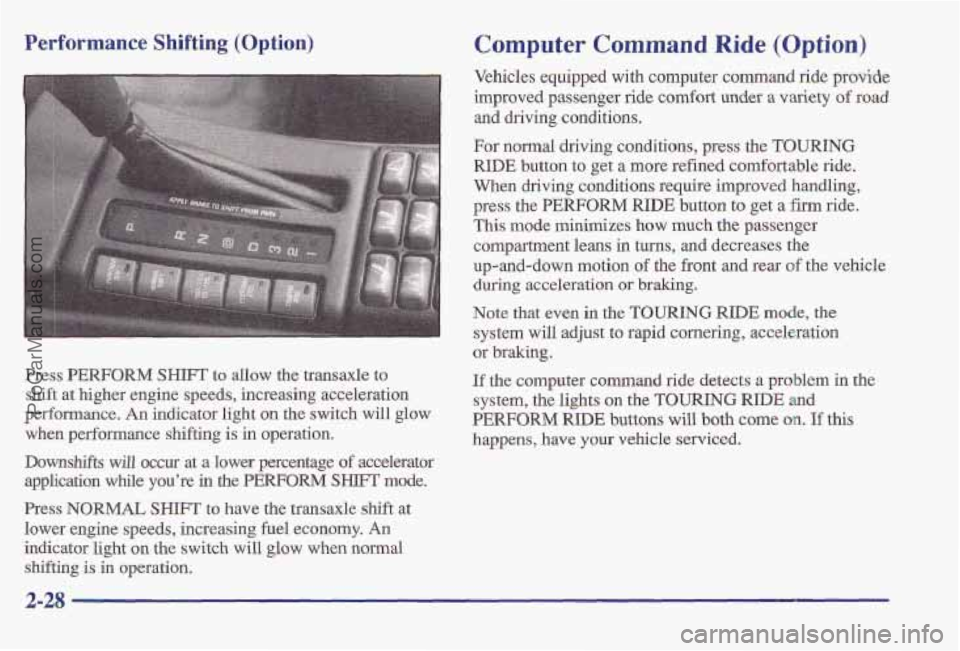
Performance Shifting (Option) Computer Command Ride (Option)
Vehicles equipped with computer command ride provide
improved passenger ride comfort under a variety of road
and driving conditions.
For normal driving conditions, press the
TOURING
RIDE button to get a more refined comfortable ride.
When driving conditions require improved handling,
press the
PERFORM RIDE button to get a firm ride.
This mode minimizes how much the passenger
compartment leans in turns, and decreases the
up-and-down motion
of the front and rear of the vehicle
during acceleration
or braking.
Press
PERFORM SHIFT to allow the transaxle to
shift at higher engine speeds, increasing acceleration
performance.
An indicator light on the switch will glow
when performance shifting is in operation.
Downshifts will occur at a lower percentage of accelerator
application while you're
in the PERFORM SHIFT' mode,
Press NORMAL
SHIFT to have the transaxle shift at
lower engine speeds, increasing fuel economy. An
indicator light
on the switch will glow when normal
shifting
is in operation. Note
that even
in the TOURING RIDE mode, the
system will adjust to rapid cornering, acceleration
or
braking.
If the computer command ride detects a problem in the
system, the lights
on the TOURING RIDE and
PERFORM RIDE buttons will both come on. If this
happens, have
your vehicle serviced.
2-28
ProCarManuals.com
Page 82 of 405

Parking Brake
Your Pontiac has a PUSH
TO RELEASE parking
brake.
To set the parking
brake, hold the regular
brake pedal down with your
right foot. Push down the
parking brake pedal with
your left foot. If the ignition
is on, the brake system
warning light will come
on and a single chime
will be heard.
If you start to drive away with the parking brake set, a
chime will sound after the vehicle has traveled
approximately
40 feet (12 m).
If you try to drive away with the parking brake on, the
brake light stays on and a chime sounds until you release
the parking brake.
NOTICE:
Driving with the parking brake on can cause
your rear brakes to overheat.
You may have to
replace them, and you could also damage other
parts
of your vehicle.
If you are towing a trailer and are parking on any hill,
see “Towing a Trailer” in the Index. That section
shows
what to do first to keep the trailer from moving.
To release the parking brake, use the PUSH TO
RELEASE parking brake pedal. Hold the regular brake
pedal down with your right foot and push the parking
brake pedal with your left foot. This will unlock the
pedal.
When you lift your left foot, the parking brake
pedal will follow it to the release position.
2-29
ProCarManuals.com
Page 91 of 405
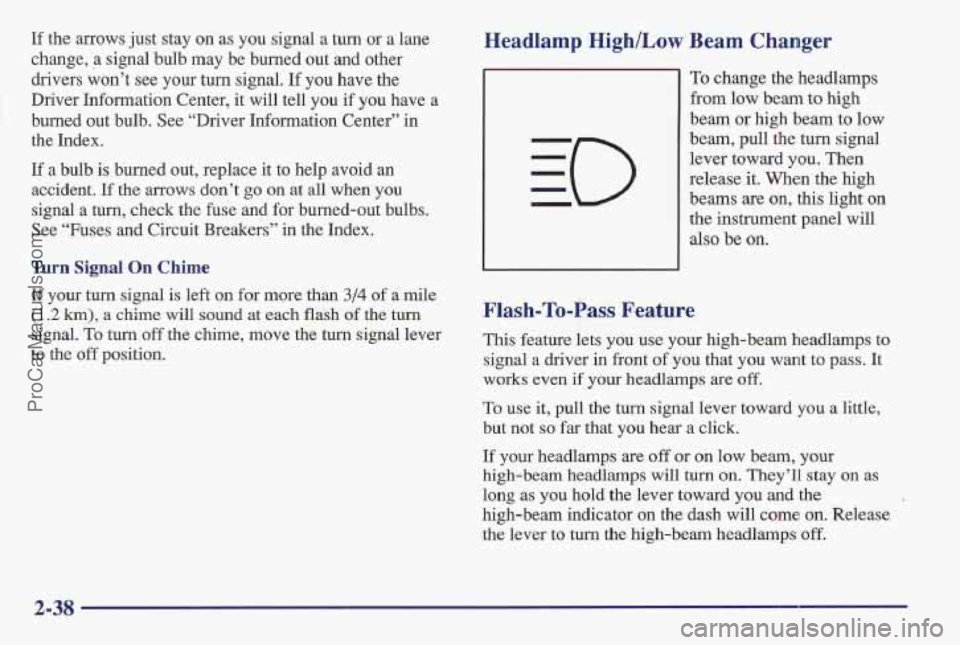
If the arrows just stay on as you signal a turn or a lane
change,
a signal bulb may be burned out and other
drivers won’t see your
turn signal. If YOU have the
Driver Information Center, it will tell you
if you have a
burned out bulb. See “Driver Infomation Center” in
the Index.
If a bulb is burned out, replace it to help avoid an
accident.
If the arrows don’t go on at all when you
signal a turn, check the fuse and for burned-out bulbs.
See “Fuses and Circuit Breakers’’ in the Index.
Turn Signal On Chime
If your turn signal is left on for more than 4/4 of a mile
(1.2 km), a chime will sound at each flash of the turn
signal.
To turn off the chime, move the turn signal lever
to the
off position.
Weadlamp High/Low Beam Changer
To change the headlamps
from low beam to high
beam
or high beam to low
beam, pull the turn signal
lever toward
you. Then
release
it. When the high
beams
are on, this light on
the instrument panel will
also be on.
Flash-To-Pass Feature
This feature lets you use your high-beam headlamps to
signal a driver in front of you that you want to pass. It
works even if your headlamps are
off.
To use it, pull the turn signal lever toward you a little,
but not
so far that you hear a click.
If your headlamps are
off or on low beam, your
high-beam headlamps will turn on. They’ll stay on as
long
as you hold the lever toward you and the
high-beam indicator on the dash will come
on. Release
the lever to turn the high-beam headlamps off.
2-38
ProCarManuals.com
Page 92 of 405
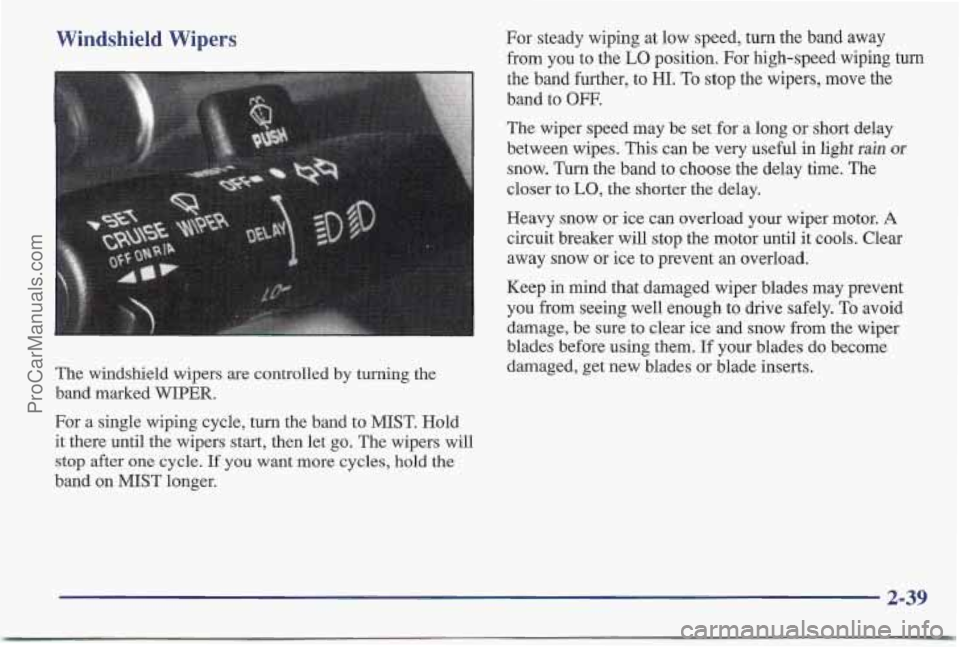
Windshield Wipers
The windshield wipers are controlled by turning the
band marked WIPER.
For a single wiping cycle, turn the band to MIST. Hold
it there until the wipers start, then let
go. The wipers will
stop after one cycle. If you want more cycles, hold the
band on MIST longer. For
steady wiping at low speed, turn the band away
from you to the
LO position. For high-speed wiping turn
the band further, to
HI. To stop the wipers, move the
band to
OFF.
The wiper speed may be set for a long or short delay
between wipes. This can be very useful
in light rain or
snow. Turn the band to choose the delay time. The
closer to
LO, the shorter the delay.
Heavy snow or ice can overload your wiper motor.
A
circuit breaker will stop the motor until it cools. Clear
away snow or ice to prevent an overload.
Keep in mind that damaged wiper blades may prevent
you from seeing well enough to drive safely. To avoid
damage, be sure to clear ice and snow from the wiper
blades before using them.
If your blades do become
damaged, get new blades or blade inserts.
2-39
ProCarManuals.com
Page 93 of 405
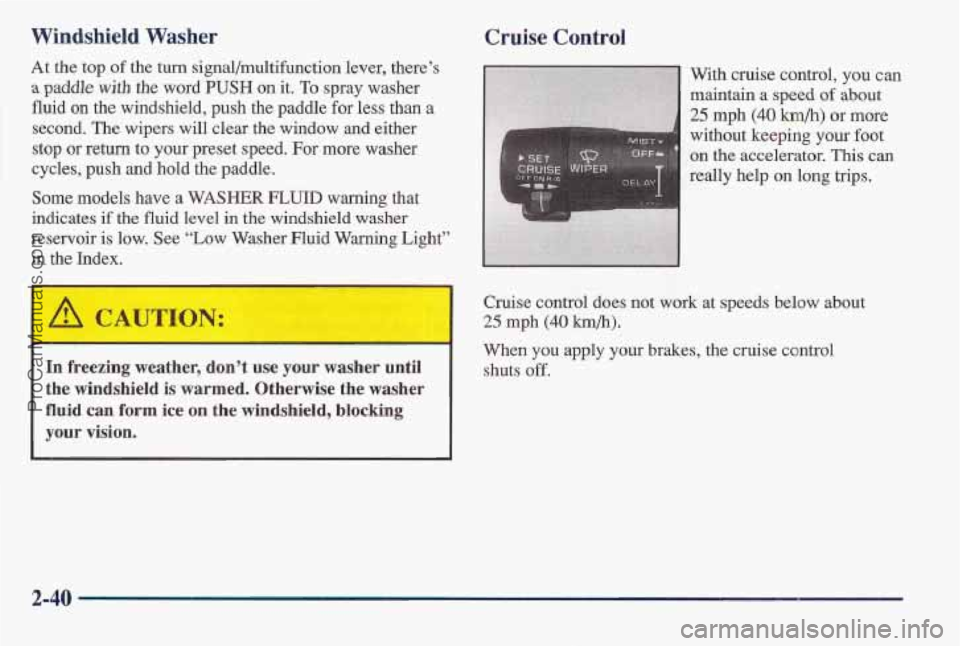
Windshield Washer Cruise Control
At the top of the turn signal/multifunction lever, there’s
a paddle with the word PUSH on it. To spray washer
fluid on the windshield, push the paddle for less than a
second. The wipers
will clear the window and either
stop or return to your preset speed. For more washer
cycles, push
and hold the paddle.
Some models have
a WASHER FLUID warning that
indicates if the fluid level in the windshield washer
reservoir is low.
See “Low Washer Fluid Warning Light”
in the Index. With cruise control,
you can
maintain a speed
of about
25 mph (40 km/h) or more
without keeping your foot
~ on the accelerator. This can
really help on long trips.
4 Cruise control do’es not work at speeds below about
I
25 mph (40 km/h).
When you apply your brakes, the cruise control
In freezing weather, don’t use your washer until shuts off.
the windshi’eld is warmed, Otherwise the washer
fluid cam €orm ice on the windshield, blocking
your vision.
2-40 ~
ProCarManuals.com
Page 96 of 405

Passing Another Vehicle While Using Cruise Control
Use the accelerator pedal to increase your speed. When
you take your foot off the pedal, your vehicle will slow
down to the cruise control speed you set earlier.
Using Cruise Control on Hills
How well your cruise control will work on hills depends
upon your speed, load and the steepness
of the hills.
When going up steep hills, you may have to step on
the
accelerator pedal to maintain your speed. When going
downhill, you may have
to brake or shift to a lower gear
to keep your speed down. Of course, applying the brake
takes you out
of cruise control. Many drivers find this to
be too much trouble and don’t use cruise control on
steep hills.
Ending Cruise Control
There are two ways to turn off the cruise control:
0 Step lightly on the brake pedal; or
0 Move the cruise switch to OFF.
Erasing Speed Memory
When you turn off the cruise control or the ignition,
your cruise control set speed memory is erased.
Exterior Lamps
Headlamps
Pull the switch to the first
stop to turn on the:
Parking Lamps
Sidemarker Lamps
0 Taillamps
Pull the switch out all the way to turn on the headlamps,
together with:
Parking Lamps
0 Sidemarker Lamps
0 Taillamps
0 Instrument Panel Lights
Push the switch in all the way to turn all the lamps off.
2-43
ProCarManuals.com